Plymouth Fury
The Plymouth Fury is a model of automobile which was produced by Plymouth from 1955 to 1989. It was introduced for the 1956 model year as a sub-series of the Plymouth Belvedere, becoming a separate series one level above the contemporary Belvedere for 1959. The Fury was a full-size car from 1959 to 1961, then a mid-size car from 1962 to 1964, again a full-size car from 1965 to 1974, and again a mid-size car from 1975 to 1978. From 1975 to 1977 the Fury was sold alongside the full-size Plymouth Gran Fury. In 1978, the B-body Fury was the largest Plymouth, and by 1979, there was no large Plymouth. This was rectified in 1980 with the R-body Gran Fury, followed by the M-body Fury in 1982. Production of the last V8, RWD Plymouth Fury ended at Kenosha, WI, on December 23, 1988. Unlike its sibling brand, Dodge, Plymouth would not live to see the resurgence of the large, V8/RWD sedan. The last Plymouth rolled off the Belvedere assembly line in 2001.
| Plymouth Fury | |
|---|---|
1959 Plymouth Sport Fury 2-door Hardtop | |
| Overview | |
| Manufacturer | Plymouth (Chrysler) |
| Production | 1955–1961 (full-size) 1961–1964 (mid-size) 1964–1974 (full-size) 1974–1978 (mid-size) |
| Model years | 1956–1961 (full-size) 1962–1964 (mid-size) 1965–1974 (full-size) 1975–1978 (mid-size) |
| Assembly | Detroit, Michigan, Lynch Road Assembly (1955-1978) Windsor, Ontario, Canada (1959-1978) |
| Body and chassis | |
| Class | Full-size (1957–1961) (1965–1974) Mid-size (1962–1964) (1975–1978) |
| Layout | FR layout |
| Chronology | |
| Predecessor | Plymouth Belvedere Plymouth Plaza Plymouth Savoy |
| Successor | Plymouth Gran Fury (full-size for 1975 to 1977, and 1980 to 1989) Plymouth Caravelle (Canada) |
Early history
The Fury was a sub-series of the Plymouth Belvedere from 1956 through 1958. It was sold only as a sandstone white two-door hardtop with gold anodized aluminum trim, in 1956 and 1957. In 1958 it was only available in buckskin beige with gold anodized aluminum trim. These Furys had special interiors, bumper wing-guards and V8 engines with twin four-barrel carburetors. The 1957 and 1958 318 cu in (5.2 L)-engine produced 290 hp (216 kW).
The 1957 models were restyled; longer, wider, with very large vertical tailfins and a new torsion bar front suspension replacing the previous coil springs. While the new styling boosted sales, quality control suffered for all Chrysler products as they were brought quickly to market before their design and construction weaknesses could be fully addressed by engineering.
In 1958, the optional engine was a 350 cu in (5.7 L) called the "Golden Commando" with two four-barrel carburetors producing 305 hp (227 kW). A 315 hp (235 kW) option with fuel injection was available, but the Bendix electronic fuel-injection system was recalled by the factory and owners were given a conventional dual four-barrel setup. The Golden Commando engine was optional on any Plymouth Plaza, Savoy, Belvedere, Suburban, and Fury, as was the dual four-barrel 318 cu in (5.2 L) (dubbed the "V-800 Dual Fury"; four- and two-barrel 318s also arrived for 1958 and were simply called "V-800s").
.jpg) 1956 Plymouth Fury
1956 Plymouth Fury.jpg) 1957 Plymouth Fury
1957 Plymouth Fury.jpg) 1958 Plymouth Fury
1958 Plymouth Fury
1959
| First generation | |
|---|---|
1959 Plymouth Sport Fury convertible | |
| Overview | |
| Model years | 1959 (Fury and Sport Fury) |
| Body and chassis | |
| Body style | 4-door sedan 4-door hardtop 2-door hardtop 2-door convertible |
| Related | Sport Suburban (4-door wagon) |
| Powertrain | |
| Engine | 303 cu in (4.97 L) "A" block V8 318 cu in (5.21 L) "A" block V8 4-bbl 350 cu in (5.7 L) "B" block V8 361 cu in (5.92 L) "B" block V8 2 & 4-bbl[1] |
| Dimensions | |
| Wheelbase | 118 in (2997 mm) |
In 1959, Plymouth introduced the Sport Fury as its top model, and the Fury as its second from the top model to replace the Plymouth Belvedere at the top of the Plymouth line-up. The Fury was now available in 4-door Sedan, 2-door Hardtop and 4-door Hardtop models and the Sport Fury as a 2-door Hardtop and a Convertible.[2] The station wagon version of the Fury was the Sport Suburban,[3] which was not marketed as a Fury.[2] The Sport Fury was dropped at the end of 1959, but was reintroduced in mid-1962 and discontinued in 1971.
In 1959, the 350 was replaced with a 361 cu in (5.92 L) version of the Golden Commando with a two- or four-barrel carburetor. The dual four-barrel version of the 318 was also dropped that year, with the four-barrel available on this engine through the 1962 model year.
- 1959 Plymouth Fury 4-door Hardtop
Dodge Viscount
The Dodge Viscount was an automobile built by Chrysler Canada for the 1959 model year only. It was based on the contemporary Plymouth Fury, but featured a 1959 Dodge front clip assembled to the Plymouth Fury body. However, there was no sport model counterpart to the Sport Fury sold in the U.S.[4]
1960–1961
| Second generation | |
|---|---|
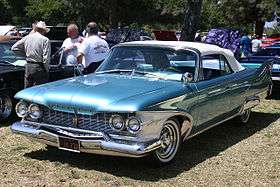 1960 Plymouth Fury convertible | |
| Overview | |
| Model years | 1960–1961 |
| Body and chassis | |
| Body style | 4-door sedan 4-door hardtop 2-door hardtop 2-door convertible |
| Related | Sport Suburban (4-door wagon) |
| Powertrain | |
| Engine | 225 cu in (3.69 L) slant-6 "30-D economy six" 1-bbl[1] 318 cu in (5.21 L) "A" V8 2 & 4-bbl[1] 361 cu in (5.92 L) "B" V8 2 & 4-bbl[1] 383 cu in (6.28 L) "B" V8 2 & 4-bbl[1] 383 cu in (6.28 L) "B" V8 2x4-bbl[1] 413 cu in (6.77 L) "RB" V8[1] |
| Transmission | 2-speed PowerFlite automatic[1] 3-speed TorqueFlite automatic[1] 3-speed TorqueFlite-6 automatic[1] 3-speed "Synchro-Silent" manual[1] 3-speed manual[1] |
| Dimensions | |
| Wheelbase | 118 in (2997 mm) |
| Length | 209.5 in (5321 mm) |
| Width | 80 in (2032 mm) |
| Height | 54.6 in (1372 mm) |
Nineteen-sixty was the first year for unibody construction,[5] the first year for Chrysler's ram induction system, and the first year for Chrysler's new slant-six engine. The original 318 and 383 were available, along with a 361. The 225 cu in (3.69 L) slant-six produced 145 hp (108 kW) at 4,000 rpm. The 383 produced 330 hp (250 kW).[1]
The Fury remained Plymouth's leading sales volume model through the early 1960s. Tailfins were removed for 1961.
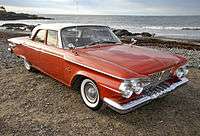 1961 Plymouth Fury four-door sedan
1961 Plymouth Fury four-door sedan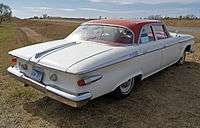 Rear view of a 1961 Fury
Rear view of a 1961 Fury
1962–1964
| Third generation | |
|---|---|
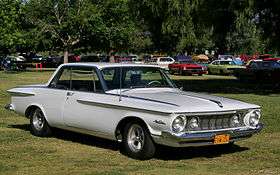 1962 Plymouth Sport Fury | |
| Overview | |
| Model years | 1962–1964 (Fury and Sport Fury) |
| Body and chassis | |
| Body style | 4-door wagon 4-door sedan 4-door hardtop 2-door hardtop 2-door convertible |
| Platform | B-body |
| Related | Dodge Custom 880 |
| Powertrain | |
| Engine | 225 cu in (3.69 L) Slant-6 "30-D Economy Six" 1-bbl[1] 318 cu in (5.21 L) "A" V8[1] 361 cu in (5.92 L) "B" V8[1] 383 cu in (6.28 L) "B" V8[6] 413 cu in (6.77 L) "RB" V8 426 cu in (6.98 L) Wedge and Hemi "B" V8[1] |
| Transmission | 3-speed TorqueFlite automatic[1] 3-speed manual[1] |
The 1962 Fury emerged as a downsized model riding on the new Chrysler B-body unibody platform, the product of a Chrysler Corporation embroiled in multiple corporate controversies at the time.[7] Sales of the new model were slow, prompting the reintroduction of the Sport Fury trim package,[8] offered as a hardtop coupe or a convertible. The 1962 range included a Fury 4-door Station Wagon,[9] the wagon equivalent of the Fury having previously been marketed as the Plymouth Sport Suburban.
Chrysler Corporation began to restyle and enlarge the Plymouths and Dodges, which improved sales in 1963 and 1964. The 1964 models saw an improvement in sales, especially the two-door hardtop, which featured a new slanted roofline. Engine choices remained the same throughout this three-year cycle.
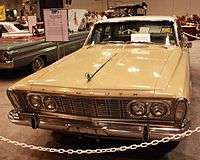 1963 Plymouth Fury Four Door Sedan
1963 Plymouth Fury Four Door Sedan.jpg) 1964 Plymouth Sport Fury Two-Door Hardtop
1964 Plymouth Sport Fury Two-Door Hardtop
1965–1968
| Fourth generation | |
|---|---|
.jpg) 1965 Plymouth Sport Fury | |
| Overview | |
| Also called | Plymouth VIP |
| Model years | 1965–1968 (Fury and Sport Fury) 1966–1968 (VIP) |
| Body and chassis | |
| Body style | 4-door wagon (1965-68) 4-door sedan (1965-68) 2-door sedan (1965-68) 4-door hardtop (1965-68) 2-door hardtop (1965-68) 2-door hardtop (1967-68 "fasttop" model) 2-door convertible (1965-68) |
| Platform | C-body |
| Related | Dodge Phoenix |
| Powertrain | |
| Engine | |
| Transmission | 3-speed automatic 3-speed manual 4-speed manual |
| Dimensions | |
| Wheelbase | 119.0 in (3,023 mm) Station Wagon: 121.0 in (3,073 mm) |
In 1965, Chrysler returned the Fury to the new, full-size Chrysler C-body platform. The new 1965 Plymouth line included three special Furys: the Fury I, Fury II, and Fury III. The Fury I was the basic model, while the Fury II and Fury III offered more trim and features. Full size Furys had options such as automatic transmissions, power steering, white sidewall tires (along with full wheel covers), stereo radios, vinyl tops, and air conditioning. The Sport Fury was the highest trim and feature model, positioned to compete with the Chevrolet Impala Super Sport and Ford Galaxie 500/XL. It offered a sportier interior and exterior trim package. The Fury II was available as a two-door hardtop in Canada only; in the U.S. it was only available as a two- or four-door sedan, and as a station wagon.
The overall design changed, with the grille losing chrome but gaining two vertical stacked headlights on each side. All rode on new 119 in (3,000 mm) wheelbases (121 in (3,100 mm) for the wagons)—1 in (25 mm) longer than before. The 426 "street wedge" V8 was introduced, rated at 385 hp (287 kW) and finally street-legal.[1]
The 1966 Furys kept the same profile as the 1965s, with a split front and rear grill motif. For 1967, the body was restyled with a sharp, angular profile. The stacked quad headlight bezels were curvier and set more deeply into the body, giving the car a more muscular look. The roofline had sharper angles and gave the car a longer, more luxurious appearance. A new, formal two-door hardtop body style appeared which featured smaller rear quarter windows and a wider, back-slanted "C" pillar. Called the "fast top", it was offered alongside the restyled thin "C" pillar hardtop in both VIP and Sport Fury series (as well as on corresponding big Dodge models). The 1967 model year introduced new safety regulations, which meant that for the first time, all Plymouths included dual-circuit brake master cylinders, energy-absorbing steering columns and wheels, recessed instrument panel controls, and shoulder belt mounting points for outboard front seat occupants.
The 1968 Furys received only minor grille updates up front, along with side marker lights and shoulder belts for front outboard occupants (except the convertibles). At the rear, however, all models except the station wagons received new sheet metal, including reshaped rear doors on four-door models.[10] Meanwhile, the Suburban badge returned to station wagons after having been retired in 1961. The Suburban, Custom Suburban, and Sport Suburban corresponded to the Fury I, II, and III models.[10]
From 1966 to 1969, a luxury version of the Fury, called the "Plymouth VIP" (marketed as the "very important Plymouth" in 1966) was fielded, in response to the Ford LTD, Chevrolet Caprice, and the AMC Ambassador DPL. These models came with standards such as full wheel covers, vinyl tops, luxuriously upholstered interiors with walnut dashboards and door-panel trim, a thicker grade of carpeting, more sound insulation, and full courtesy lighting.
In Australia, the full size Dodge Phoenix was based on the Dodge Dart and 440 until 1965, when it became a right-hand drive version of the contemporary Fury. The Phoenix continued in production in Australia until 1972, each based on that year's North American Plymouth Fury.
- 1966 Plymouth Sport Fury convertible
.jpg) 1967 Plymouth Sport Fury 2-door fast top
1967 Plymouth Sport Fury 2-door fast top.jpg) 1968 Plymouth Fury III 2-door hardtop
1968 Plymouth Fury III 2-door hardtop.jpg) 1968 Plymouth Sport Suburban
1968 Plymouth Sport Suburban
1969–1973
| Fifth generation | |
|---|---|
1969 Plymouth Sport Fury Convertible | |
| Overview | |
| Also called | Plymouth VIP |
| Model years | 1969–1973 (Fury) 1969–1971 (Sport Fury) 1969 (VIP) |
| Body and chassis | |
| Body style | 2-door hardtop 2-door convertible 4-door sedan 4-door hardtop 4-door station wagon |
| Platform | C-body |
| Related | Dodge Phoenix (Australia) |
| Powertrain | |
| Engine | |
| Dimensions | |
| Wheelbase | 120.0 in (3,048 mm) |
The 1969 models featured Chrysler's new round-sided "Fuselage Look" styling. The Fury was again available as a 2-door hardtop, 2-door convertible, 4-door hardtop, 4-door sedan, and 4-door station wagon. For 1970, the VIP was discontinued and a 4-door hardtop was added to the Sport Fury range, which also gained a new hardtop coupe. This was available in "GT" trim; the 1970 and 1971 Sport Fury GTs were powered by the 440 cu in (7.2 L) engine, which in 1970 could be ordered with three 2-barrel (twin-choke) carburetors (the "6-Barrel on Plymouth and 6-PAK for Dodge"). This engine produces 350 hp (261 kW).[11]
The 1969 models included the Fury I, Fury II and Fury III, the sport-model Sport Fury and the top-line VIP. The 225 cubic-inch six-cylinder engine continued as standard on the Fury I, II and select III models, with the 318 cubic-inch V8 standard on the Sport Fury, some Fury III models, and all VIP models plus the station wagon; a three-speed manual transmission was standard, with the TorqueFlite automatic transmission optional. The six-cylinder engine/three-speed manual transmission power team – along with the three-speed manual transmission on the 318 cubic-inch V8 – continued to be available until midway through the 1971 model year, after which all full-sized Plymouths were built with a V8 engine, including the new 360 cubic inch engine and automatic transmission. Parking lights now illuminated with the headlights, which meant that if one headlight was inoperative in low beam, that other drivers wouldn't mistake your car for a motorcycle in the dark.
For 1970, the VIP was dropped, with the Sport Fury line expanded to include a four-door hardtop sedan. An optional Brougham package, which included individually-adjustable split bench seats with passenger recliner and luxurious trim comparable to the former VIP series, was available on Sport Furys; a Sport Fury GT and S/23 models. The S/23 was dropped for 1971, with new options including an electric sunroof (for top-line models) and a stereo tape player with a microphone, making it possible to record off the radio or take dictation.
The 1971s offered a new Sport Fury 4-door sedan, and a coupe (similar to the Sport Fury hardtop but with fixed rear quarter windows) in the Fury I series. A hardtop coupe was now available in the Fury II series, and a Formal Hardtop was available for both Sport Fury and Fury III. New options included headlight washers, and a stereo cassette recorder.
For 1972, the Fury was facelifted with a large chrome twin-loop bumper design with a small insignia space between the loops and hidden headlamps as standard equipment on the Sport Suburban, and the newly introduced Fury Gran Coupe and Gran Sedan, which eventually would become the Plymouth Gran Fury; the Sport Fury and GT models were dropped, while the new Fury Gran series offered an optional Brougham package.[12] The six-cylinder engine, strangled by emissions requirements, was no longer offered in full-size Plymouths. On the other hand, a 400 cubic inch V8 was now an option.[12] For 1973, the front end was redesigned with a new grille and headlamp setup, along with bumpers capable of withstanding 5 mph (8 km/h) impacts. The 360 became the standard engine for Fury Suburbans.[13]
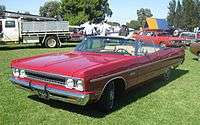 1969 Fury III Convertible
1969 Fury III Convertible.jpg) 1970 Fury III convertible
1970 Fury III convertible.jpg) 1971 Fury II sedan, rear view
1971 Fury II sedan, rear view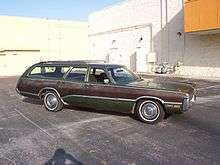 1972 Fury Sport Suburban station wagon
1972 Fury Sport Suburban station wagon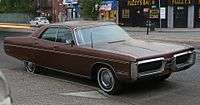 1972 Fury Gran Sedan with hidden headlamps
1972 Fury Gran Sedan with hidden headlamps
1974
| Sixth generation | |
|---|---|
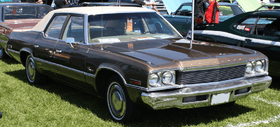 1974 Plymouth Fury 4-door sedan | |
| Overview | |
| Production | 1973–1974 |
| Model years | 1974 |
| Body and chassis | |
| Body style | 4-door wagon 4-door sedan 4-door hardtop 2-door hardtop |
| Platform | C-body |
| Powertrain | |
| Engine | 318 cu in (5.21 L) "LA" V8[1] 360 cu in (5.9 L) "LA" V8[1] 400 cu in (6.6 L) "B" V8[1] 440 cu in (7.2 L) "RB" V8[1] |
| Dimensions | |
| Wheelbase | 121.5 in (3,086 mm) |
For 1974, the Fury shared Chrysler's all-new full-size C-body platform in common with the concurrent flagship Imperial (1974-75); Chrysler New Yorker (1974-78), Newport (1974-78) and Town & Country (1974-77); and with the Dodge Monaco (1974-76) and Royal Monaco (1977) as well. Styling was more squared off with lower beltlines and greater use of glass than with Chrysler's previous fuselage generation (1969-73), also with cues more similar to the model year 1971 and later Buicks and model year 1973–74 Mercurys. The unibody structure with subframe for engine/transmission was retained along with other typical Chrysler Corporation engineering features including torsion bar front suspension and multi-leaf springs in the rear.
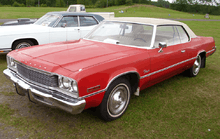
Model lineup again included the Fury I, Fury II, Fury III and Gran Fury series, plus the Suburban and Sport Suburban station wagons. Engine offerings included a standard 360 cu in (5.9 L) V8 with two-barrel carburetor on sedans and coupes, a two-barrel 400 cu in (6.6 L) V8 standard on wagons and optional on other models, and four-barrel carbureted 400 and 440 cu in (7.2 L) V8s optional on all models.
All 1974 Furys came standard with TorqueFlite automatic transmissions, power steering, and power front disc brakes.
As part of the company's efforts to make ordering a well-equipped car easier, two special model packages were available: a basic group (which had items already ordered on a majority of full-sized Plymouths, such as an AM radio, air conditioning, light group and tinted glass) and a luxury group (which added items such as cruise control, power windows and an AM/FM stereo radio). The Brougham package, whose centerpiece was the individually-adjustable 50/50 divided front seat with individual center armrests and recliners, was still available for Gran Furys. New options included Chrysler's chronometer (an electronic digital clock), a gauge alert system that used light-emitting diodes to monitor engine functions and automatic temperature control.
For information on Chrysler's full-size C-body Plymouth (from model years 1975-77), see Plymouth Gran Fury.
1975–1978
| Seventh generation | |
|---|---|
1978 Plymouth Fury 4-door sedan | |
| Overview | |
| Model years | 1975–1978 |
| Body and chassis | |
| Body style | 4-door wagon 4-door sedan 2-door hardtop/coupe |
| Platform | B-body |
| Powertrain | |
| Engine | 225 cu in (3.69 L) slant-6 "30-D economy six" 1-bbl[1] 225 cu in (3.69 L) Slant-6 2-bbl (1976–1978)[1] 318 cu in (5.21 L) "LA" V8 2-bbl[1] 360 cu in (5.9 L) "LA" V8 2 & 4-bbl[1] 400 cu in (6.6 L) "B" V8 2 & 4-bbl[1] 440 cu in (7.2 L) "Magnum" V8 4-bbl (police 4-door sedan)[1] |
| Dimensions | |
| Wheelbase | Sedan: 117.5 in (2,984 mm) Coupe: 115.0 in (2,921 mm) |
For the 1975 model year, Chrysler moved the Fury name, which had been part of the full-size C-body Plymouth model line up during the previous ten model years, over to the restyled mid-size B-body line, which had been marketed as the Satellite previously. The "Road Runner" was offered as the top-of-the-line model of the redesigned Plymouth Fury 2-door line up, then it was moved over to the Plymouth Volare line up during the following model year (1976). The full-size Plymouth, now known as the Plymouth Gran Fury, lasted through 1977. The entire mid-size Plymouth Fury line up was discontinued at the end of the 1978 model year, replaced in Canada by the rebadged Dodge Diplomat model called the Plymouth Caravelle (not to be confused with the E-body Plymouth Caravelle from 1983 to 1988 and the 1985 to 1988 Plymouth Caravelle for the American car market). During the entire 1979 model year, there were no Fury offerings from Plymouth at all.
Only minor styling changes occurred from the 1975 to the 1978 model years, most notably, during the 1977 model year when quad stacked square headlights (see photo) replaced the previous round dual beam headlights, the front turn signals, previously on the outboard edges of the grille, were moved over to the cutouts in the front bumper. Tail lights received amber turn signal lenses in place of the previous red turn signal lenses. Various 2-door models had no centerposts and some of them were true hardtops with roll-down rear windows. Other two-door models had fixed rear windows even though they had no centerposts. For the most part, the Plymouth Fury two-door models, during the 1975 and the 1978 model years, were labeled as "hardtops".

The Plymouth Fury, 1975-1978, shared its B-body and unibody structure with the Dodge Coronet (1975-1976), Dodge Monaco (1977-1978) and the corporation's new personal-luxury coupe models, Chrysler Cordoba (1975-1979) and Dodge Charger SE (1975-1978). All the four-door models, wagons and sedans alike, continued with the basic body shells, which date back to the start of the 1971 model year, rode on a 118 in (2,997 mm) wheelbase, while the various two-door models—which were restyled with new and more formal sheetmetal and rooflines—rode on the 115 in (2,921 mm) wheelbase.
Before 1975, the Plymouth Satellite had a 117 in (2,972 mm) wheelbase, while the Dodge Coronet had a 118 in (2,997 mm) wheelbase. For 1975, the mid-size Plymouth Fury had a 117.5 in (2,984 mm) wheelbase and the 1975 Dodge Coronet had the same wheelbase.
Before 1974, the Plymouth Fury had a 120 in (3,048 mm) wheelbase, while the Dodge Monaco/Polara had a 122 in (3,099 mm) wheelbase. For 1974, the Plymouth Gran Fury and Dodge Monaco had the same 121.5 in (3,086 mm) wheelbase.
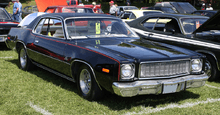
Fury was offered in three basic subseries for 1975 in sedans and coupes and two for the station wagon. The sedan was offered in base, custom and salon models, with interior and exterior trim ranging from austere to luxurious. The salon featured plush velour bench seats with recliners and folding armrests and carpeted trunks, along with a spring-loaded hood ornament with the Plymouth logo. In addition to the Road Runner, the Fury coupes were offered in base, Custom and Sport models. The "sport" was the top-line coupe featuring body pinstriping on the upper door and front and rear fenders, interiors with all-vinyl bucket seats and center cushion and armrest, or optional center console; or split bench seats with armrest, along with plusher shag carpeting on floor and door panels plus lower door carpeting. The wagons were available as either the Fury Suburban or Fury Custom Suburban.
Engine offerings included the 225 cu in (3.69 L) slant-six that was standard on all models except Fury Sport, Road Runner, and station wagons, which came with the 318 cu in (5.21 L) V8 as the base engine which was optional on other models. Optional engines on all models included 360 cu in (5.9 L) and 400 cu in (6.6 L) V8s with two- or four-barrel carburetor, and the 440 cu in (7.2 L) four-barrel was only as a "police" option on four-door sedans. A three-speed manual transmission was standard with the automatic TorqueFlite optional.
The 1976 model year mid-size B-body 1976 Plymouth Fury saw very few appearance changes from the previous year other than the availability of a dual opera window roof on Sport Fury two-door models. Engine and transmission offerings were also unchanged except that the 360 two-barrel V8 was now the standard engine on station wagons along with the TorqueFlite automatic transmission, both items of which were optional on other models.
The 1977 model year mid-size B-body 1977 Plymouth Fury received a new front end with a chrome vertical bar grille and outline along with stacked rectangular headlights. Model and drivetrain offerings were unchanged from 1976 except that the Slant Six now had two-barrel carburetion replacing the one-barrel pot of previous years and was now standard on the Sport Fury two-door models. Optional V8 engines included the 318 two-barrel, 360 two- or four-barrel and 400 two- or four-barrel. The 440 four-barrel V8 was only offered in four-door models as part of the police package.
The 1978 model year was technically a mid-size B-body car, but the 1978 Plymouth Fury was Plymouth's largest car with the discontinuation of the full-size C-body Plymouth Gran Fury after 1977. TorqueFlite automatic transmission and power steering were now standard on all Fury models and the same selection of V8 engines was still available. Few appearance changes were made from the previous model year. The 1978 was the last model year for the Plymouth Fury and its Dodge Monaco counterpart, which was renamed as such during the start of the previous model year (1977), which, in turn, was called the "Dodge Coronet" (from 1965, 1966 to 1967, 1968 to 1970, 1971 to 1974 and from 1975 on through to 1976), while the former full-size C-body Dodge was renamed the "Dodge Royal Monaco" during the start of the previous model year (1977) up until it was discontinued after just one model year. The personal-luxury coupes, which were based on the mid-size B-body platform, including the Chrysler Cordoba and Dodge Magnum (renamed from Charger in 1978) would soldier on for one more year until they were downsized (and renamed Mirada for the Dodge version) in 1980 to the M-body platform used for the Dodge Diplomat and Chrysler LeBaron.
Gran Fury
1979–1981
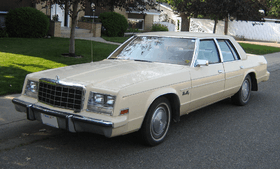
For 1979, the B-body chassis/unibody structure was recycled for the corporation's R-body full-sized car, which was a considerably downsized replacement of the 1974–78 C-body cars. Those R-body cars included the Chrysler Newport, Chrysler New Yorker, and Dodge St. Regis Plymouth version was the Gran Fury although not very common. Plymouth Gran Fury was used on the big car market with a new Gran Fury that was a twin of the concurrent Chrysler Newport intended mainly for fleet sales and law enforcement duties.
1982–1989
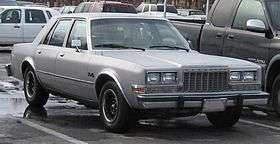
For 1982 the M-body Dodge Diplomat was rebadged to create another iteration of the Gran Fury. This version, available through the 1989 model year, was a popular choice for police cruisers. The Chrysler New Yorker (1982) and New Yorker Fifth Avenue (1983) (renamed Chrysler Fifth Avenue for (1984–89)) shared the Gran Fury and Dodge Diplomat body.
In popular culture
A 1958 Plymouth Fury was the title subject of the 1983 best-selling novel Christine by Stephen King. Later in the same year the book was adapted into a movie of the same name.
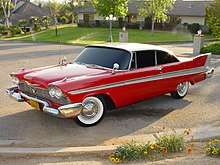
References
- "History of the Plymouth Fury". Retrieved 2008-08-18.
- 1959 Plymouth brochure, www.uniquecarsandparts.com.au Retrieved 6 May 2020
- John Gunnell, Standard Catalog of American Cars 1946–1975, Revised 4th Edition, pages 655 & 656
- Godshall, Jeffrey I.; Wagner, James K. (January 1994). "Maple Leaf Mutants: Chrysler North of the Border". Automobile Quarterly. 32 (3): 107–108. Retrieved 2015-08-16.
- "Chrysler moves to Unibody (unit-body construction): 1960". www.allpar.com. Retrieved 2 April 2018.
- Godec, Joe. "The Sonoramic Commando Plymouth engine of 1960–61". Allpar.com. Retrieved 2012-05-02.
- Redgap, Curtis. "1962 Plymouth Sport Fury car reviews". allpar.com. Retrieved 2011-04-20.
- Redgap, Curtis. "1962 Plymouth Sport Fury car reviews". allpar.com. Retrieved 2016-03-12.
- 1962 Plymouth brochure, paintref.com Retrieved 6 May 2020
- Lee, John (1990). Standard Catalog of Chrysler, 1924-1990. Iola, WI: Krause Publications, Inc. p. 407. ISBN 0-87341-142-0.
- Lee, p. 411
- Lee, p. 415
- Lee, p. 417
External links
| Wikimedia Commons has media related to |
- 1965 – 1978 Plymouth Fury and Related Full Size Mopars
- 1969 – 1973 Plymouth Fury at Fuselage.de site
- 59sportfury.net
- 1966 Plymouth Sport Fury in the Netherlands
- 1970 Plymouth Sport Fury